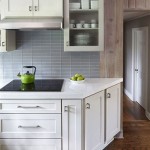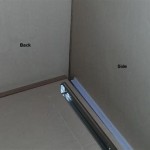```html
How To Keep Your White Kitchen Cabinets Cleaner
White kitchen cabinets offer a timeless and bright aesthetic, making them a popular choice for homeowners. However, their pristine appearance can quickly be compromised by everyday spills, splatters, and accumulated grime. Maintaining the cleanliness of white cabinets requires a consistent approach and the use of appropriate cleaning techniques to prevent stains and ensure their long-term beauty.
The challenge with white cabinets lies in their susceptibility to discoloration. Grease, food particles, and even airborne dust can adhere to the surface, creating a dull or yellowed appearance over time. Therefore, a proactive cleaning strategy, combining regular light cleaning with periodic deep cleaning, is essential to preserve their brightness and prevent permanent staining. This article will outline the key methods and best practices for effectively cleaning and maintaining white kitchen cabinets.
Daily and Weekly Cleaning
The foundation of clean white cabinets is regular maintenance. Daily spot cleaning prevents spills from setting, while weekly cleaning removes accumulated dust and grime. This proactive approach minimizes the need for intensive cleaning later and helps preserve the cabinet finish.
For daily spot cleaning, a soft, damp cloth is usually sufficient. Immediately wipe away any spills, especially those involving grease, coffee, or brightly colored foods. Avoid using abrasive sponges or scouring pads, as these can scratch the surface and dull the finish. A mild dish soap solution can be used for more stubborn spills. Ensure the surface is thoroughly dried after wiping to prevent water spots or damage to the cabinet material.
Weekly cleaning should involve wiping down all cabinet surfaces with a damp cloth and a gentle cleaning solution. A mixture of warm water and a mild dish soap is generally effective for removing dust, fingerprints, and light grease. Again, avoid abrasive cleaners. For painted cabinets, be particularly careful not to saturate the surface, as excessive moisture can damage the paint. For laminate cabinets, ensure the edges are sealed to prevent water from seeping in and causing swelling.
Pay particular attention to areas around the stove and sink, as these are more prone to splatters and moisture exposure. Regularly cleaning the hardware, such as knobs and pulls, can also contribute to the overall cleanliness of the cabinets. A soft brush can be used to remove any dirt or grime that accumulates around the hardware.
Deep Cleaning Methods
Even with regular maintenance, white kitchen cabinets will require periodic deep cleaning to remove embedded dirt, grease, and stains. The frequency of deep cleaning will depend on the level of use and cooking habits, but generally, a quarterly or semi-annual deep clean is recommended.
Several effective cleaning solutions can be used for deep cleaning white cabinets. One popular and generally safe option is a baking soda paste. Mix baking soda with a small amount of water to form a thick paste. Apply the paste to stained areas and gently scrub with a soft cloth or sponge. The mild abrasive quality of baking soda helps to lift stains without damaging the cabinet finish. Rinse thoroughly with clean water and dry.
Another option is a mixture of vinegar and water. Vinegar is a natural degreaser and disinfectant, making it effective for removing grease and grime. Mix equal parts white vinegar and water in a spray bottle. Spray the solution onto the cabinet surfaces and let it sit for a few minutes. Wipe away the solution with a clean cloth and dry thoroughly. Be cautious when using vinegar on painted cabinets, as it can sometimes dull the finish. Always test the solution on an inconspicuous area first.
For particularly stubborn stains, a melamine sponge, often referred to as a "magic eraser," can be used. These sponges are mildly abrasive and can effectively remove marks and stains that other cleaners cannot. However, it is important to use them sparingly and with caution, as they can potentially scratch or dull the cabinet finish. Always test the sponge on an inconspicuous area first and use light pressure when cleaning.
When deep cleaning, it is also important to clean the inside of the cabinets. Remove all items from the cabinets and wipe down the shelves and walls with a damp cloth. This is also a good opportunity to declutter and reorganize the cabinets.
Preventative Measures and Long-Term Care
Beyond regular cleaning, several preventative measures can be taken to protect white kitchen cabinets and extend their lifespan. These measures focus on minimizing exposure to staining agents and protecting the cabinet finish from damage.
One of the most effective preventative measures is to use a backsplash. A backsplash protects the wall behind the stove and sink from splatters and spills, preventing them from reaching the cabinets. Choose a backsplash material that is easy to clean, such as tile or glass.
Proper ventilation is also crucial for maintaining clean cabinets. Use the range hood when cooking to vent steam and grease away from the cabinets. This helps to prevent grease from accumulating on the cabinet surfaces. Ensure that the range hood filter is cleaned regularly to maintain its effectiveness.
Consider using placemats and coasters to protect cabinet surfaces from spills and stains. This is particularly important for countertops and islands that are used for food preparation. Wipe up spills immediately to prevent them from setting into the surface.
Avoid placing hot items directly on the cabinet surfaces, as this can damage the finish. Use trivets or hot pads to protect the cabinets from heat. Similarly, avoid using harsh chemicals or abrasive cleaners on the cabinets, as these can damage the finish over time.
Periodically inspect the cabinets for any signs of damage, such as chips, scratches, or water damage. Repair any damage promptly to prevent it from worsening. A touch-up paint can be used to cover small chips and scratches. If there is significant water damage, it may be necessary to replace the affected cabinet components.
The type of finish on the cabinets will also influence the cleaning methods and preventative measures that should be used. Painted cabinets are more susceptible to damage from moisture and harsh chemicals, so it is important to use gentle cleaning solutions and avoid over-saturating the surface. Laminate cabinets are more durable and resistant to moisture, but they can still be damaged by abrasive cleaners. Solid wood cabinets require special care to prevent warping and cracking. Consult with a professional for advice on cleaning and maintaining the specific type of cabinets in the kitchen.
By implementing these cleaning methods and preventative measures, homeowners can effectively maintain the cleanliness and beauty of their white kitchen cabinets, ensuring that they remain a bright and welcoming focal point of the kitchen for years to come. A consistent approach and the use of appropriate cleaning techniques are key to preserving the pristine appearance of white cabinets and preventing stains and damage.
```
3 Super Easy Ways To Clean White Kitchen Cabinets And Avoid

How To Keep Your White Kitchen Cabinets Spotless

What S The Best Way To Clean Your White Kitchen Cabinets Ag Williams

A Complete Guide To Keeping Your White Kitchen Cabinets Clean

How To Clean Sticky Grease Off Kitchen Cabinets Ovenclean

The Complete Guide To Keeping White Cabinets Clean Cabinet Now

How To Keep White Kitchen Cabinets Clean A Year Of Food

Have No Fear It Is Possible To Keep Your White Kitchen Houzz
:max_bytes(150000):strip_icc()/ways-to-clean-wood-kitchen-cabinets-3017289-01-765f893e7cca49a1ab72d7c49efdf518.jpg?strip=all)
Tips For Cleaning Food Grease From Wood Cabinets

How To Keep Your White Kitchen
Related Posts








